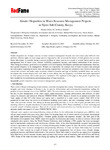| dc.description.abstract | Gender disparities are of major concern, in water resources management because men and women play different roles and have different rights on water usage and it is important to take in account the interest of both genders into account. Njoro Sub-county is currently facing a serious problem of water scarcity as a result of several factors such as poor management, loss of forest cover, climatic variability, population increase, and limited endowment of the resource. Water being an economic good and a cost attached to its development, distribution, operation and maintenance there has been gender disparity in its management. Women are responsible for multiple uses of water resources and principal decision-makers regarding domestic uses and sharing responsibility with men for productive uses. However men often control this resource and make major decisions related to location and type of facilities available hence the need to investigate why women despite their vital stake in water affairs, they are frequently overlooked and under-represented in water policy decisions and in water projects committees. The argument in this paper is that gender disparities may have resulted in overexploitation and mismanagement of water resources. | en_US |

